Photos from our work during the summer season 1996/97 here at the South Pole
To get some more background information about AMANDA (Antarctic Muon And Neutrino Detector Array, go to:
AMANDA
(Antarctic Muon and Neutrino Detector Array)
Physics behind the experiments
(for non-physicists)
We were deploying six new strings in the polar ice cap this year. Each string has 36 PMT (Photo Multiplier Tubes). The 1950m deep holes were drilled with a hot water drill.
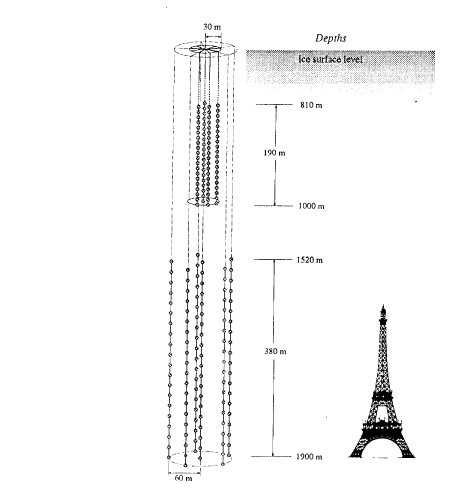
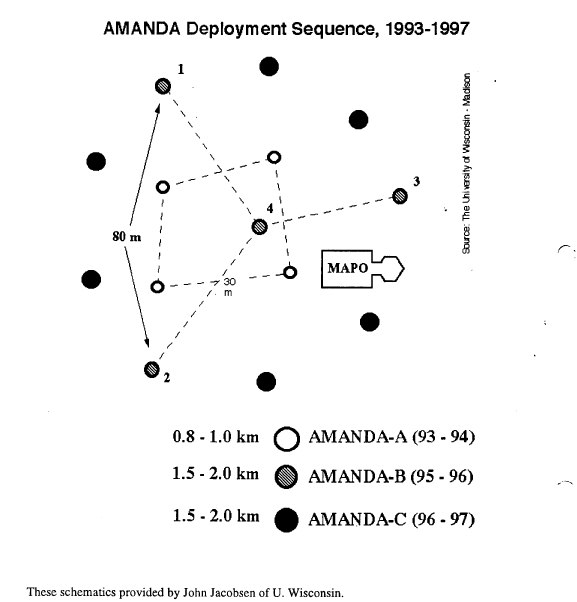
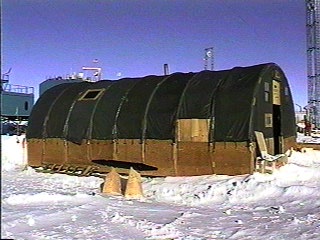 This is our Jamesway were we
spent a lot of time to reassamble the PMT's with new connectors. This was also the site of
the final testing and preparing of the PMT's for the deployment.
This is our Jamesway were we
spent a lot of time to reassamble the PMT's with new connectors. This was also the site of
the final testing and preparing of the PMT's for the deployment.
 View of the PICO (Polar Ice Coring
Office) drill site. If steam was visible, PICO was drilling.
View of the PICO (Polar Ice Coring
Office) drill site. If steam was visible, PICO was drilling.
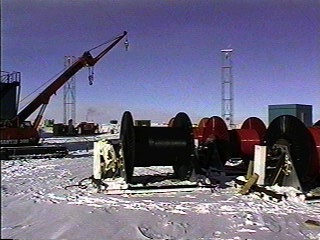 The spools are for the PICO hot
water hoses and the electrical cables. In the background are the two drill towers, set up
for hole #10 and #9.
The spools are for the PICO hot
water hoses and the electrical cables. In the background are the two drill towers, set up
for hole #10 and #9.
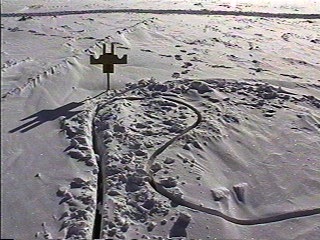 Melted marks in the snow, caused
by hot water running through hoses.
Melted marks in the snow, caused
by hot water running through hoses.
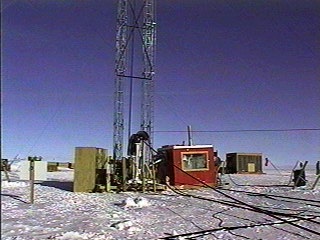 Hole #10, the 6th and last one in
this season just before deployment.
Hole #10, the 6th and last one in
this season just before deployment.
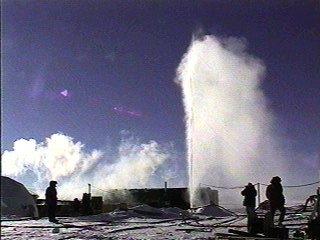 PICO discovers water at South
Pole
PICO discovers water at South
Pole
 Not really, after the last hole
is drilled, PICO gets rid of some hot water and celebrates the success with an artifical
geyser.
Not really, after the last hole
is drilled, PICO gets rid of some hot water and celebrates the success with an artifical
geyser.
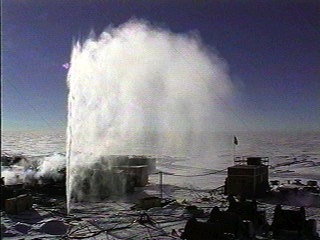
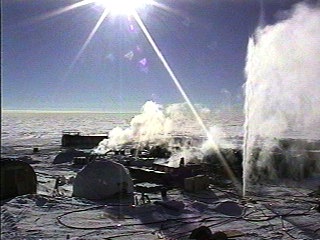 Overview of the drill site and
the geyser.
Overview of the drill site and
the geyser.
 Close up of the geyser.
Close up of the geyser.
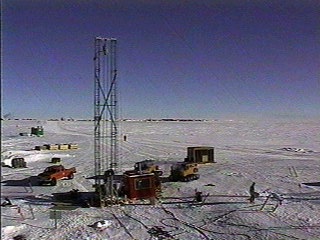 Last preparations at hole #10
for the deployment of the last string.
Last preparations at hole #10
for the deployment of the last string.
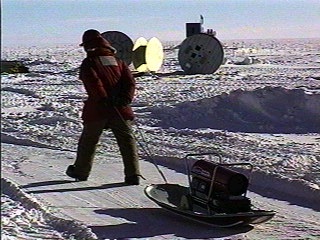 I'm bringing the big heater to the
hole.This was a very helpful device.
I'm bringing the big heater to the
hole.This was a very helpful device.
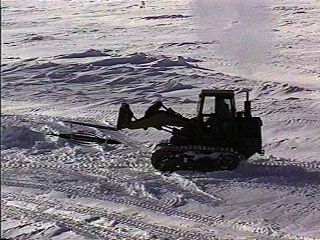 JP takes the drill (ca. 300 kg)
with a cat to the PICO drill shack.
JP takes the drill (ca. 300 kg)
with a cat to the PICO drill shack.
 Some of the pools PICO stores
hot water in. If they are not constantly heated they turn into ice blocks pretty fast.
Some of the pools PICO stores
hot water in. If they are not constantly heated they turn into ice blocks pretty fast.
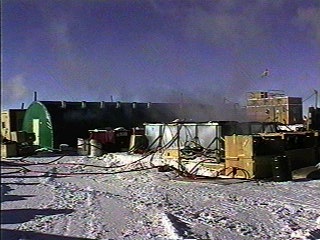 The big pool and the heater
Jamesway. The water is heated up to 80°C.
The big pool and the heater
Jamesway. The water is heated up to 80°C.
 After the drill is removed the
fork brings our winches in position, left the main cable, right the optical fibre.
After the drill is removed the
fork brings our winches in position, left the main cable, right the optical fibre.
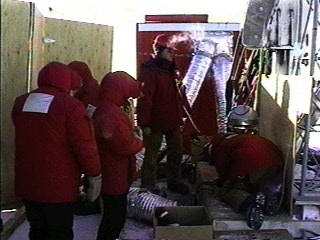 Deployment of the last string
has started, PMT by PMT goes into the hole.
Deployment of the last string
has started, PMT by PMT goes into the hole.
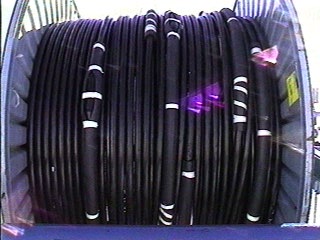 The main cable, for the HV of the
PMT's and the signals. You can see the breakouts for each optical module (PMT).
The main cable, for the HV of the
PMT's and the signals. You can see the breakouts for each optical module (PMT).
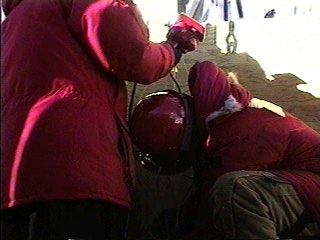 That's me working on one of the
modules. Thomas is holding a heat gun. The temperatures were so cold that you had to heat
tape, connectors and everything else before you could use it.
That's me working on one of the
modules. Thomas is holding a heat gun. The temperatures were so cold that you had to heat
tape, connectors and everything else before you could use it.
 Just checking...
Just checking...
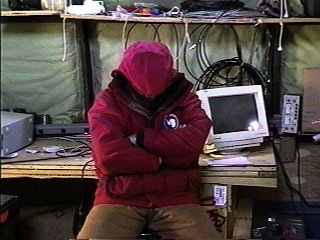 Gary is taking some rest
during lunch break.
Gary is taking some rest
during lunch break.
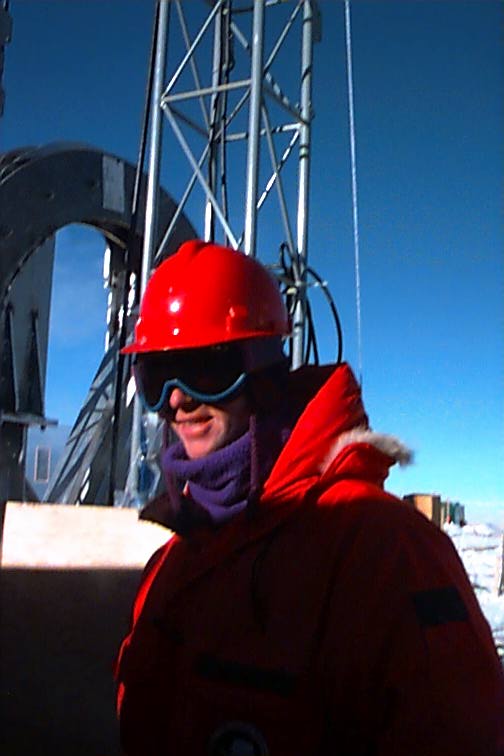 A couple of more and we are done :))))
A couple of more and we are done :))))
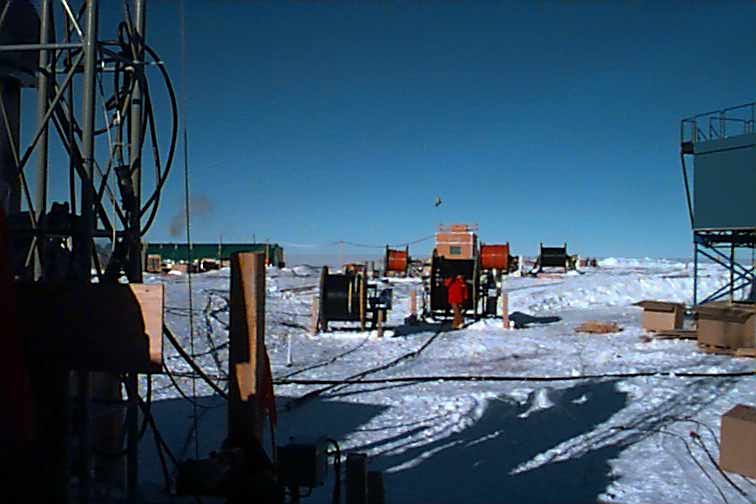
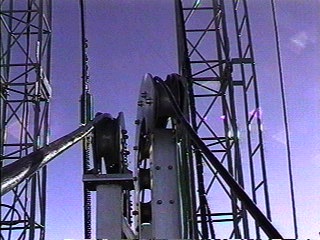
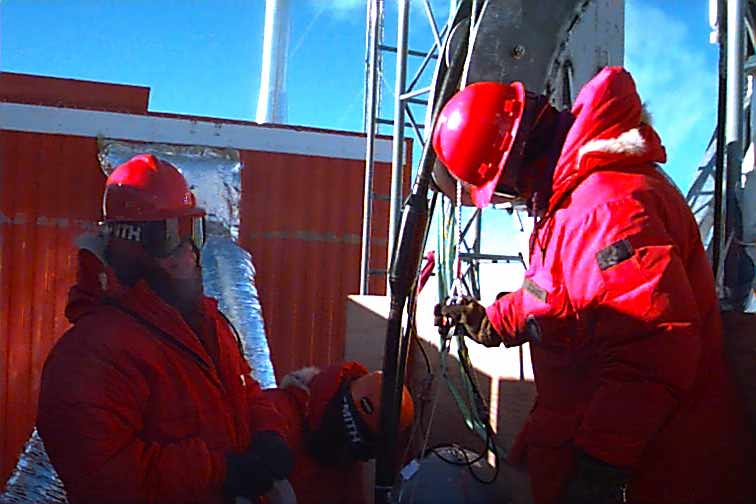 Three people were always working at the hole. Here Ralf, Glenn and I.
Three people were always working at the hole. Here Ralf, Glenn and I.
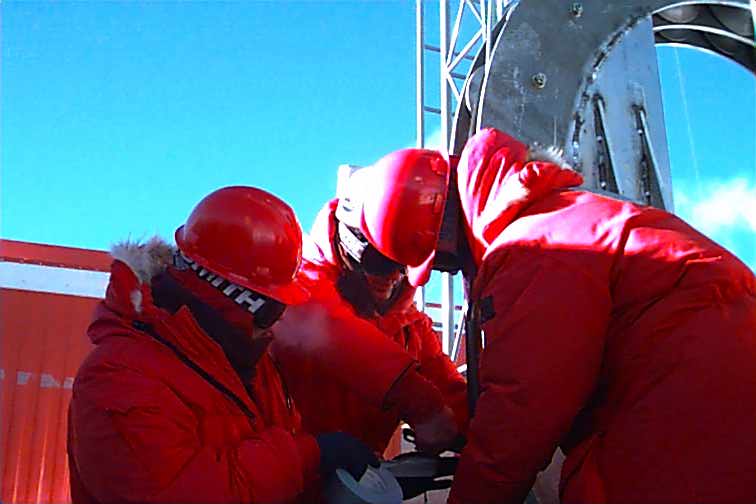

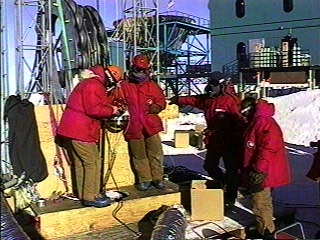 This is our last module out of 216
we deployed in the ice, plus some extra devices.
This is our last module out of 216
we deployed in the ice, plus some extra devices.
 Yeah, it's done.
Yeah, it's done.
 Connecting the last module and it's
done. After that follows the drop from about 350m down to 1860m depth.
Connecting the last module and it's
done. After that follows the drop from about 350m down to 1860m depth.
 Down the hole!
Down the hole!
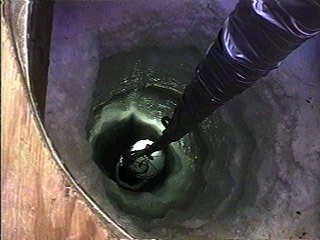 A mirror brings some sunlight down.
A mirror brings some sunlight down.
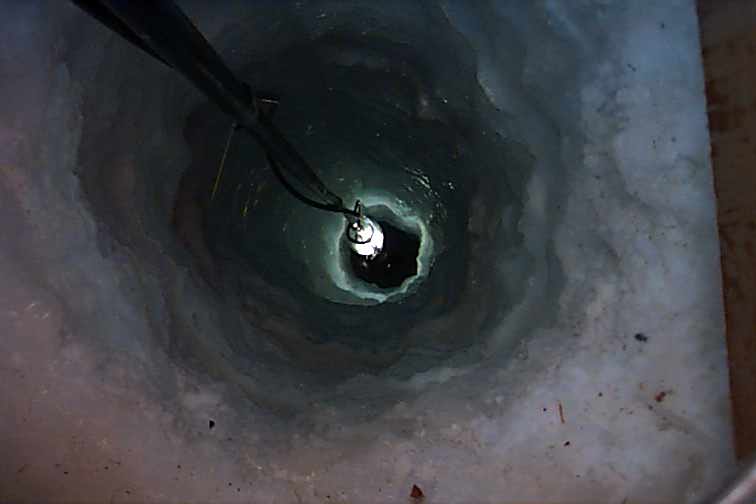
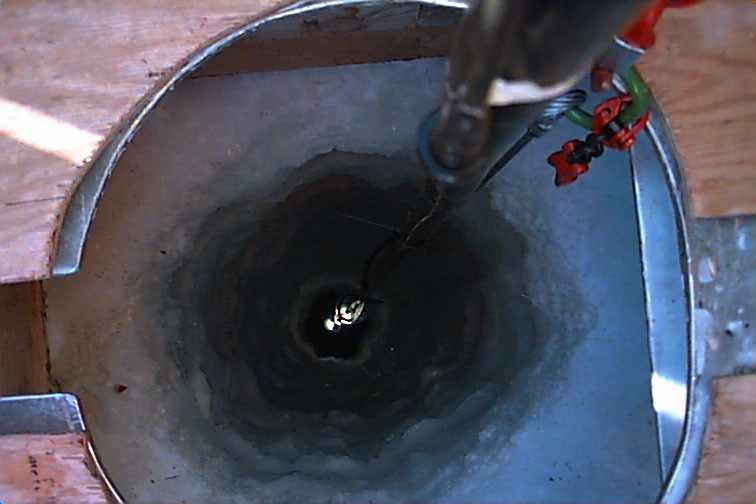
 A close up of a module in the hole.
You can see the main cable with the breakout and the fibre cable.
A close up of a module in the hole.
You can see the main cable with the breakout and the fibre cable.
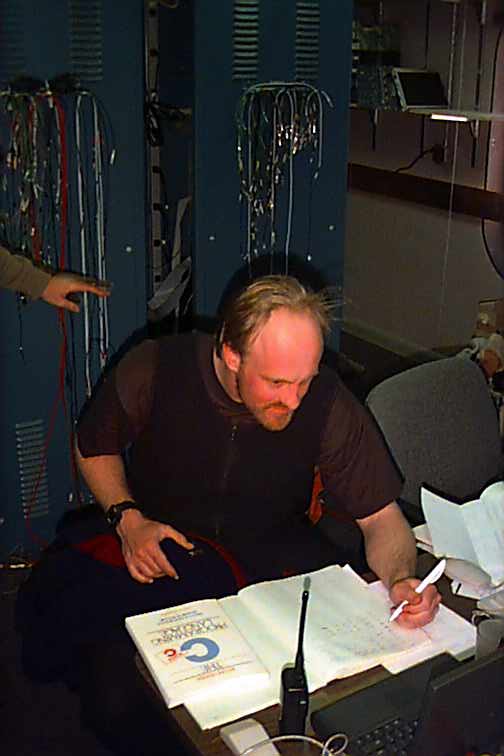 But with
the deployment the work wasn't over. Now all the calibration of the new modules began. Here
is Gary, the other winterover for AMANDA taking measurements.
But with
the deployment the work wasn't over. Now all the calibration of the new modules began. Here
is Gary, the other winterover for AMANDA taking measurements.
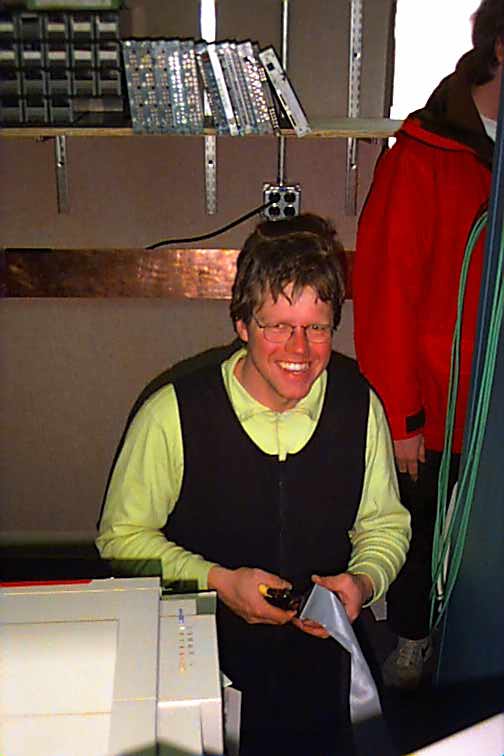 Thomas is
preparing new cables.
Thomas is
preparing new cables.
 The
deployment and calibration days were long and everybody lacked sleep.
The
deployment and calibration days were long and everybody lacked sleep.
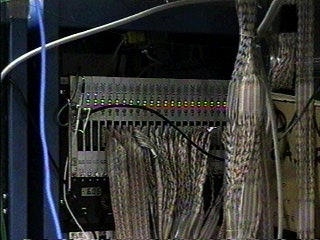 Hundreds of cables and blinking
LED's, here the SNMP (Super Nova/Mono Pole) experiment.
Hundreds of cables and blinking
LED's, here the SNMP (Super Nova/Mono Pole) experiment.
 cables, cables.....
cables, cables.....
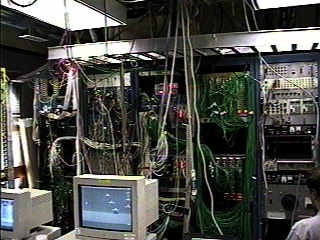 These are the racks for AMANDA B.
302 PMT's are monitored here.
These are the racks for AMANDA B.
302 PMT's are monitored here.
 This side is for AMANDA A, 80 PMT's.
This side is for AMANDA A, 80 PMT's.
 The whole room is stocked with
electronic racks and computers. Without heating and air circulation the room is heated
by all these electronics easily above 32°C (90°F). Actually one of the biggest
problems here at South Pole is cooling. Because we are located at about 3000m (10000ft)
the air is already so thin, that there is not an efficient airflow through all the
electronics.
The whole room is stocked with
electronic racks and computers. Without heating and air circulation the room is heated
by all these electronics easily above 32°C (90°F). Actually one of the biggest
problems here at South Pole is cooling. Because we are located at about 3000m (10000ft)
the air is already so thin, that there is not an efficient airflow through all the
electronics.
 AMANDA B
AMANDA B
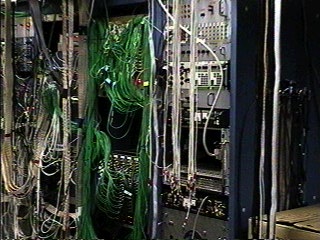 and more cables...
and more cables...
 We don't wanna talk about the ones behind the racks.
We don't wanna talk about the ones behind the racks.
 The first data taken by the new
strings.
The first data taken by the new
strings.
 Most of the new modules are alive
and providing data.
Most of the new modules are alive
and providing data.
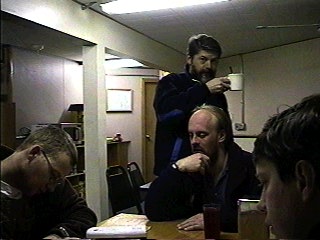 Another meeting.
Another meeting.
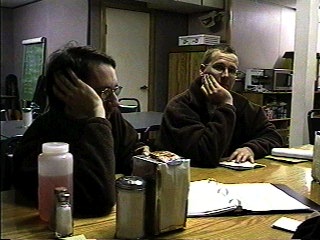 Live from the meeting.
Live from the meeting.
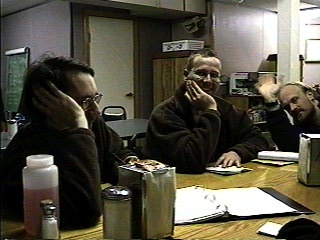
 Our computers inside the Dome.
Our computers inside the Dome.
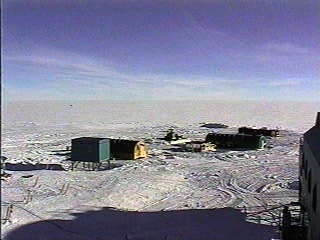 The closed down drill site
empty and abandoned.
The closed down drill site
empty and abandoned.
 Soon only flags will indicate the
new holes.
Soon only flags will indicate the
new holes.
back to "Life at South Pole
back to homepage
© copyright, 1997, Robert Schwarz. All rights reserved


 This is our Jamesway were we
spent a lot of time to reassamble the PMT's with new connectors. This was also the site of
the final testing and preparing of the PMT's for the deployment.
This is our Jamesway were we
spent a lot of time to reassamble the PMT's with new connectors. This was also the site of
the final testing and preparing of the PMT's for the deployment. View of the PICO (Polar Ice Coring
Office) drill site. If steam was visible, PICO was drilling.
View of the PICO (Polar Ice Coring
Office) drill site. If steam was visible, PICO was drilling. The spools are for the PICO hot
water hoses and the electrical cables. In the background are the two drill towers, set up
for hole #10 and #9.
The spools are for the PICO hot
water hoses and the electrical cables. In the background are the two drill towers, set up
for hole #10 and #9. Melted marks in the snow, caused
by hot water running through hoses.
Melted marks in the snow, caused
by hot water running through hoses. Hole #10, the 6th and last one in
this season just before deployment.
Hole #10, the 6th and last one in
this season just before deployment. PICO discovers water at South
Pole
PICO discovers water at South
Pole Not really, after the last hole
is drilled, PICO gets rid of some hot water and celebrates the success with an artifical
geyser.
Not really, after the last hole
is drilled, PICO gets rid of some hot water and celebrates the success with an artifical
geyser.
 Overview of the drill site and
the geyser.
Overview of the drill site and
the geyser. Close up of the geyser.
Close up of the geyser.
 Last preparations at hole #10
for the deployment of the last string.
Last preparations at hole #10
for the deployment of the last string. I'm bringing the big heater to the
hole.This was a very helpful device.
I'm bringing the big heater to the
hole.This was a very helpful device. JP takes the drill (ca. 300 kg)
with a cat to the PICO drill shack.
JP takes the drill (ca. 300 kg)
with a cat to the PICO drill shack. Some of the pools PICO stores
hot water in. If they are not constantly heated they turn into ice blocks pretty fast.
Some of the pools PICO stores
hot water in. If they are not constantly heated they turn into ice blocks pretty fast.
 The big pool and the heater
Jamesway. The water is heated up to 80°C.
The big pool and the heater
Jamesway. The water is heated up to 80°C. After the drill is removed the
fork brings our winches in position, left the main cable, right the optical fibre.
After the drill is removed the
fork brings our winches in position, left the main cable, right the optical fibre.
 Deployment of the last string
has started, PMT by PMT goes into the hole.
Deployment of the last string
has started, PMT by PMT goes into the hole. The main cable, for the HV of the
PMT's and the signals. You can see the breakouts for each optical module (PMT).
The main cable, for the HV of the
PMT's and the signals. You can see the breakouts for each optical module (PMT).
 That's me working on one of the
modules. Thomas is holding a heat gun. The temperatures were so cold that you had to heat
tape, connectors and everything else before you could use it.
That's me working on one of the
modules. Thomas is holding a heat gun. The temperatures were so cold that you had to heat
tape, connectors and everything else before you could use it.
 Just checking...
Just checking... Gary is taking some rest
during lunch break.
Gary is taking some rest
during lunch break. A couple of more and we are done :))))
A couple of more and we are done :))))

 Three people were always working at the hole. Here Ralf, Glenn and I.
Three people were always working at the hole. Here Ralf, Glenn and I.

 This is our last module out of 216
we deployed in the ice, plus some extra devices.
This is our last module out of 216
we deployed in the ice, plus some extra devices. Yeah, it's done.
Yeah, it's done. Connecting the last module and it's
done. After that follows the drop from about 350m down to 1860m depth.
Connecting the last module and it's
done. After that follows the drop from about 350m down to 1860m depth. Down the hole!
Down the hole! A mirror brings some sunlight down.
A mirror brings some sunlight down.


 A close up of a module in the hole.
You can see the main cable with the breakout and the fibre cable.
A close up of a module in the hole.
You can see the main cable with the breakout and the fibre cable. But with
the deployment the work wasn't over. Now all the calibration of the new modules began. Here
is Gary, the other winterover for AMANDA taking measurements.
But with
the deployment the work wasn't over. Now all the calibration of the new modules began. Here
is Gary, the other winterover for AMANDA taking measurements. Thomas is
preparing new cables.
Thomas is
preparing new cables. The
deployment and calibration days were long and everybody lacked sleep.
The
deployment and calibration days were long and everybody lacked sleep.
 Hundreds of cables and blinking
LED's, here the SNMP (Super Nova/Mono Pole) experiment.
Hundreds of cables and blinking
LED's, here the SNMP (Super Nova/Mono Pole) experiment.
 cables, cables.....
cables, cables..... These are the racks for AMANDA B.
302 PMT's are monitored here.
These are the racks for AMANDA B.
302 PMT's are monitored here. This side is for AMANDA A, 80 PMT's.
This side is for AMANDA A, 80 PMT's.
 The whole room is stocked with
electronic racks and computers. Without heating and air circulation the room is heated
by all these electronics easily above 32°C (90°F). Actually one of the biggest
problems here at South Pole is cooling. Because we are located at about 3000m (10000ft)
the air is already so thin, that there is not an efficient airflow through all the
electronics.
The whole room is stocked with
electronic racks and computers. Without heating and air circulation the room is heated
by all these electronics easily above 32°C (90°F). Actually one of the biggest
problems here at South Pole is cooling. Because we are located at about 3000m (10000ft)
the air is already so thin, that there is not an efficient airflow through all the
electronics. AMANDA B
AMANDA B and more cables...
and more cables... We don't wanna talk about the ones behind the racks.
We don't wanna talk about the ones behind the racks.
 The first data taken by the new
strings.
The first data taken by the new
strings. Most of the new modules are alive
and providing data.
Most of the new modules are alive
and providing data. Another meeting.
Another meeting. Live from the meeting.
Live from the meeting.
 Our computers inside the Dome.
Our computers inside the Dome. The closed down drill site
empty and abandoned.
The closed down drill site
empty and abandoned. Soon only flags will indicate the
new holes.
Soon only flags will indicate the
new holes.